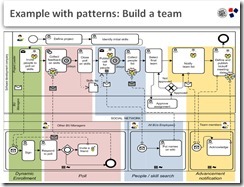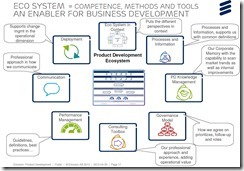Since the Microsoft Worldwide Partner Conference (WPC) ended up in my backyard this year, I decided to drop by for a couple of sessions. There’s a lot here that’s not all that interesting to me – more for the partners’ sales teams on how to sell more Microsoft stuff – but it’s a good opportunity for me to catch up on a few product announcements and also see some of my vendor contacts who are also Microsoft partners.
You can watch the keynotes and some other interviews online and follow the Twitter stream; this morning, we heard about how Windows 8 is going to be the biggest thing since Windows 95, and saw some of the new hardware that’s being developed to take advantage of the new features.
This afternoon in a breakout, Jared Spataro from SharePoint product management gave an update on trends and the product direction, although they are not yet ready to talk about SharePoint/Office 15 so I have the sense that there will be some more interesting stuff coming out later in the summer that we didn’t hear today. He did outline what they see as key industry trends:
- Social. Well, duh, they just spend over $1B on Yammer. The next session is on enterprise social, and it’s not surprising that they’re looking at social in a business context.
- Consumers, and the consumerization of IT.
- Devices, and allowing their customers to work on whatever device they have. He claims that they no longer have a protectionist policy of supporting only Microsoft platforms, but maybe they should talk to their conference organizers about having something other than a Windows Phone app for the conference.
- Cloud to reduce the time to value as well as support a broader audience. They intend to develop for the cloud first for SharePoint as well as all of Microsoft Office, and see cloud as a strategic platform for enterprises of all sizes in the future. They don’t necessarily see that organizations are going to move existing on-premise systems to the cloud, but that it will become the platform of choice (and completely seamless to the end user due to single sign-on) for new deployments, and they’re developing more tools for hybrid (cloud/on-premise) solutions.
- Cross-organization support for collaboration outside a single enterprise, which is obviously supported by the cloud platform.
Over 65% of companies with SharePoint have deployed to their entire employee population, which is a good indication of the viral nature (which you can consider to be good or bad) adoption of SharePoint. About half of their base has updated to SharePoint 2010, although I see a lot of my clients with much older versions, and Microsoft needs to think about how to move them off those old versions so that they can start to leverage the collaboration capabilities rather than just a place to dump documents.
Their focus now is to transition from being a document-centric system to a people-centric system: making it a more personalized experience for each user, so that SharePoint provides the context, content and platform for doing their work. They’re starting to see more companies managing projects using SharePoint, not just storing documents, so are trying to better support conversations about documents rather than just the documents themselves. Bringing together search, content, workflow and social into a single platform has a lot of potential, especially considering the market penetration of SharePoint.
With just that whiff of what’s coming in SharePoint 15, he moved on to their FY2013 field sales priorities (which is what all these partners are crowded into the room to hear):
- Win “enterprise social”, so that every new social experience in a customer is a Microsoft experience. They’ll be doing some social roadshows to back this up and keep the momentum going, so that they start winning a lot of the social deals.
- Launch SharePoint 15, which pushes the social message broader and deeper into the enterprise.
- Drive new seats with Office365, especially in the mid-market in the cloud.
They want to use social as a conversation-starter, but continue to move in with SharePoint and Office core functionality, pushing upgrades and cloud migration. They also see Yammer as something that business can do without a lot (or even any) IT support, so that they can start using social enterprise software without deploying internally. Then, as Microsoft develops stronger ties between Yammer and SharePoint (as they must), Yammer will leverage users into a social-enabled SharePoint.
We were left with quite a number of large gaps in upcoming product information, since they are not quite ready to spill on the features of the next version. Frustrating, but I understand that public companies just can’t do too much in the way of pre-announcements.
Spataro left half of the hour-long session for questions, and the first one was about the perceived weaknesses of the platform for BPM and workflow. He admitted that they have not spent a lot of energy making SharePoint a premier BPM platform, and that they’re really focused on capturing the market share while leaving some of the functionality to partners. There are a number of BPM-related ISV partners here at WPC this week, including AgilePoint, K2, Kofax, Laserfiche and OpenText, plus services partners who build process-centric solutions; Microsoft has to tread carefully so as not to provide functionality that undercuts their partners’ business, and partners are always at risk that Microsoft will decide that their business is just a bit too strategic to leave to partners. I find it hard to believe that there’s not some sort of BPM work going on within the core SharePoint platform, since process is becoming a key competency in many organizations and Microsoft is unlikely to walk away from that opportunity to develop deeper ties into their customers’ business operations and IT infrastructure. That risk, of course, is the nature of being a partner with a huge software company such as Microsoft (or IBM, SAP and many others): like sleeping with an elephant, it’s toasty-warm most of the time, but watch out when it rolls in your direction.


